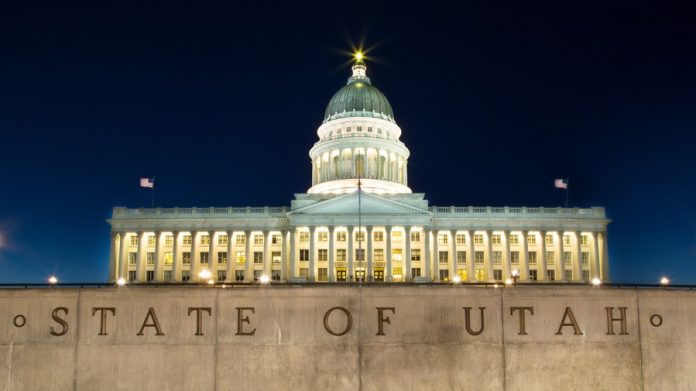
Utah may be the next state to redraw its congressional lines amid a growing redistricting battle across the country.
A judge ruled last month that Utah legislators went around safeguards against partisan gerrymandering with their latest lines — which shored up Republican control of Utah’s four House seats — and must redistrict before the midterms.
The ruling may face additional legal challenges, but both sides of the case reportedly agreed this past week on a timeline that could lead to changes as soon as this fall.
Unlike redistricting efforts in Texas and California, where plans were put forward to boost party margins in the House, Utah would be forced to redraw by the court order. But experts say that new maps could offer a rare opening for Democrats to gain a seat in the ruby-red state.
Here’s what to know.
Why is Utah being forced to redraw?
District Judge Dianna Gibson ruled last month that Utah’s Republican-controlled state Legislature went around voter-approved anti-gerrymandering protections with the latest congressional lines and must redraw ahead of next year’s midterms.
Voters in Utah approved an independent redistricting commission via ballot initiative back in 2018, but that setup was effectively repealed and rendered advisory by a state law passed in 2020.
The next year, legislators disregarded a proposal from the commission, drawing maps that have earned an F-grade from the Gerrymandering Project’s “Report Card.”
Gibson’s new ruling came after a Utah Supreme Court decision last year said the state Legislature doesn’t have the power to revise voter-approved reform initiatives, as it did with the measure related to redistricting.
In the new ruling, Gibson said the current maps are unlawful because lawmakers had essentially ignored the voter-passed proposition. Barring any further legal complications, state lawmakers will have to toss the existing lines and come up with new ones before the midterms — and they’ll have roughly a month to produce a new set.
What does it mean for Utah Democrats?
All four of Utah’s congressional districts are held by Republicans, and the state went to President Trump by nearly 22 points last November. The last Democrat to control a House seat in the state was former Rep. Ben McAdams, who was unseated in 2020, just two years after flipping the seat.
The maps cut up Salt Lake County, a blue dot in the otherwise conservative state; the redrawing could make space for a blue — or at least more competitive — district.
“When they redistricted after 2020, all those districts became more Republican,” said Matthew Burbank, a University of Utah political science professor.
“I think what Democrats are hoping here is they get some version of [a] district that’s situated in Salt Lake County, and that would at least make Democrats competitive in that district.”
Experts predict a scramble among Democrats if such a seat were created. Utah Political Watch recently reported that McAdams could be among those eyeing a future bid.
“I think under any redrawn map, you’re going to get an elevated interest from Democrats, even if just out of curiosity to see if the new district gives them a better chance than the party has had in Utah,” said Damon Cann, head of Utah State University’s political science department.
Utah Democrats have called the district court ruling a “mandate for change” in the state and said they’re “ready to hit the ground running next year.”
How are Republicans responding?
Shortly after the ruling came down, Sen. Mike Lee (R-Utah) claimed Utah’s electoral system is “under attack by Democrats and their leftist allies in the Utah courts.”
President Trump, who has encouraged the GOP-led redistricting in Texas, called the judge’s ruling “absolutely Unconstitutional.”
“How did such a wonderful Republican State like Utah, which I won in every Election, end up with so many Radical Left Judges? … This incredible State sent four great Republicans to Congress, and we want to keep it that way,” Trump wrote on Truth Social.
Utah Gov. Spencer Cox (R) said he disagreed with the ruling during an event in D.C. last week, according to the Utah News Dispatch, but he acknowledged that voters “did run an initiative and they felt like they’re being ignored.”
Republicans, who already tried unsuccessfully to stall the latest ruling, can appeal to the state Supreme Court, but experts said they’re unlikely to succeed so recently after state court’s decision.
“My guess is the state Supreme Court, having just made this ruling, is not likely to revisit it at this point. I think they’re largely likely to say, ‘Yep, looks like what the district court judge did was follow the ruling that we laid out,’” Burbank said.
Are any incumbents affected?
Depending on how lines are drawn, particularly around Salt Lake County, any of Utah’s Republican members of Congress could be put at risk.
Draft maps have yet to emerge, but analysis from the Cook Political Report suggests that Rep. Burgess Owens (R) would be “the most obvious target,” as he represents the largest number of Salt Lake County voters. But fellow Republican Reps. Blake Moore, Celeste Maloy, and Mike Kennedy could also see shifts to their districts.
The independent commission proposed several maps in 2021, all of which kept Salt Lake City intact and would have created a district that went to former Vice President Kamala Harris by double digits in 2024, according to Cook.
“If the Legislature ultimately decides that they need to create what becomes a blue district, and say ‘Alright, we’ll lose one. Let’s make it this one’ – you’ve got four incumbents and you’ve got three safe districts, and you have to start making decisions,” Cann said.
Utah doesn’t require lawmakers to live in the districts they campaign to represent, meaning any incumbent whose district is impacted by new lines could choose to run in another, Cann noted, potentially teeing up incumbent-on-incumbent match-ups.
How will the process play out?
Barring any snags along the way, Utah could see new maps take hold quickly.
Top Republicans in the state Legislature last month called the court ruling “misguided” and the 30-day deadline to produce maps “arbitrary,” but said they would move forward with redrawing the state’s congressional map.
“While we will continue to pursue every legal option available—including requesting a stay from the Utah Supreme Court if necessary—we will attempt to redistrict under these unprecedented constraints, consistent with our oath to represent the best interests of Utah,” state Senate President J. Stuart Adams and state House Speaker Mike Schultz said in an Aug. 28 joint statement.
A timeline submitted to Gibson, as shared by multiple local outlets sets a Sept. 25 deadline for the Legislature to make new maps public. A public comment period, a Legislature vote and a hearing on the maps would likely follow over roughly a month.
Experts say the maps would need to be finalized quickly to take effect before the midterms, as required by the ruling.
“If you’re going to try to do things with districts for the 2026 election – and we’re really, really close to the cut off for being able to manage that, given what county clerks have to be able to do to set things up and be ready for filing periods … this is the moment,” Cann said.

